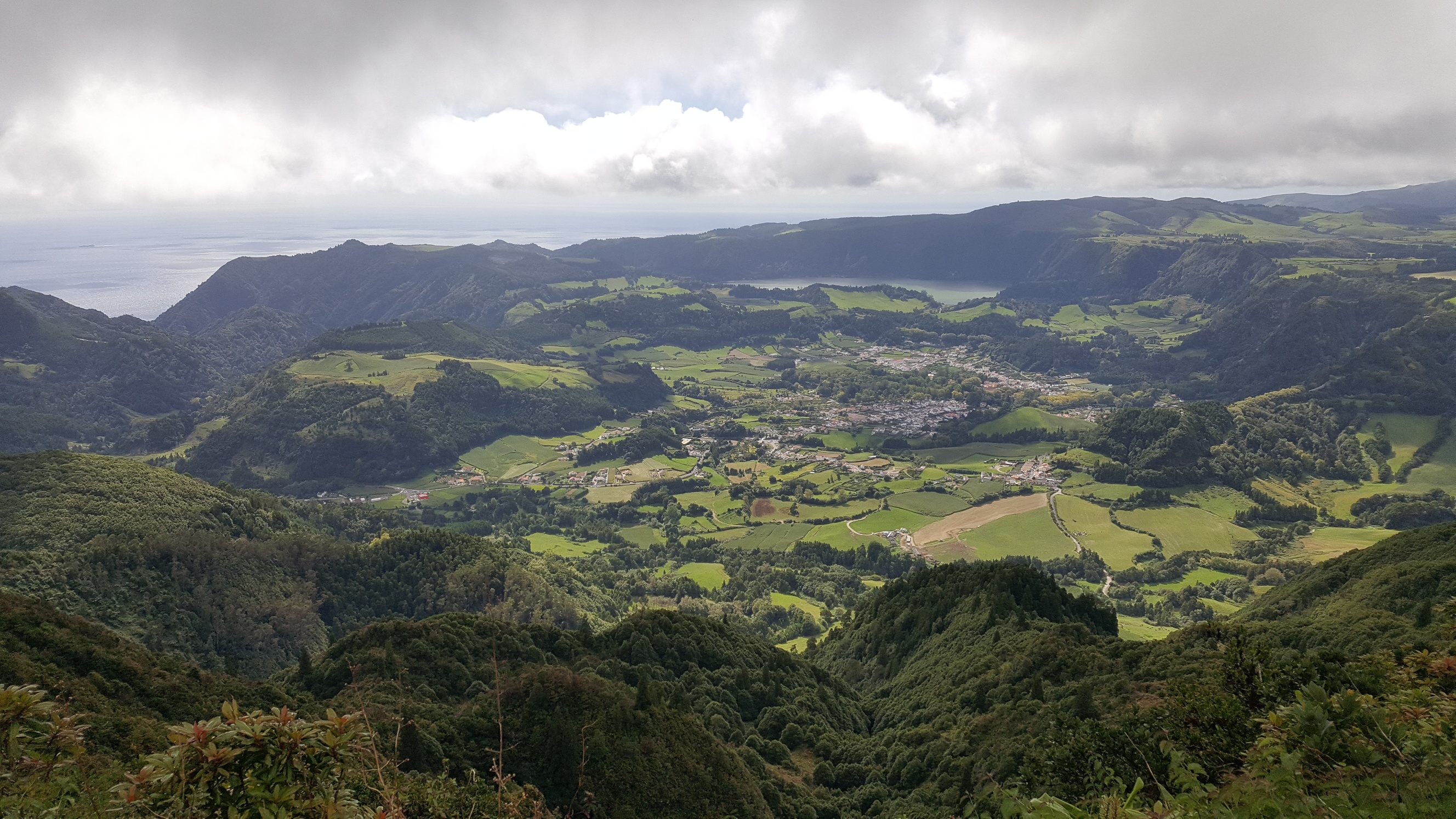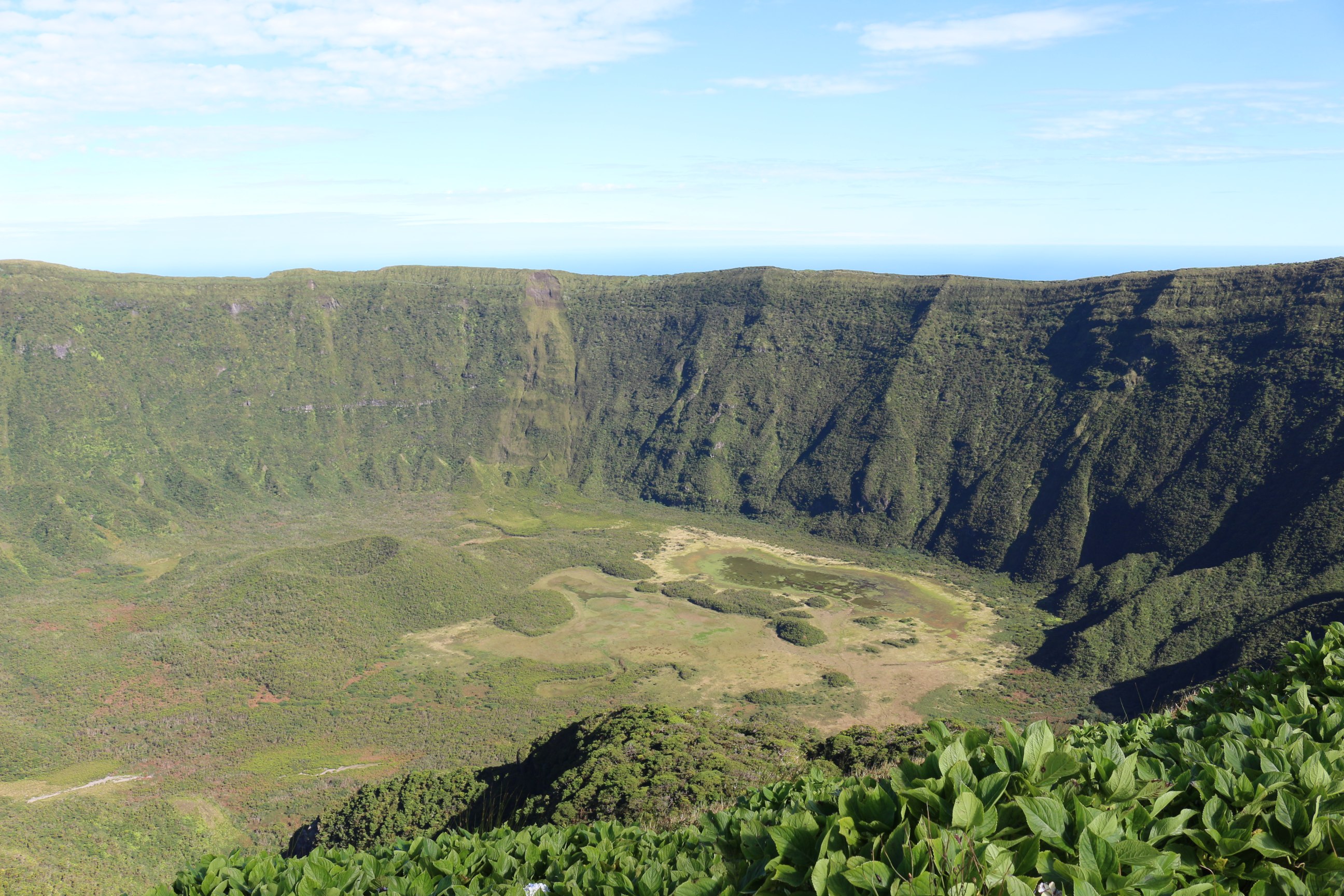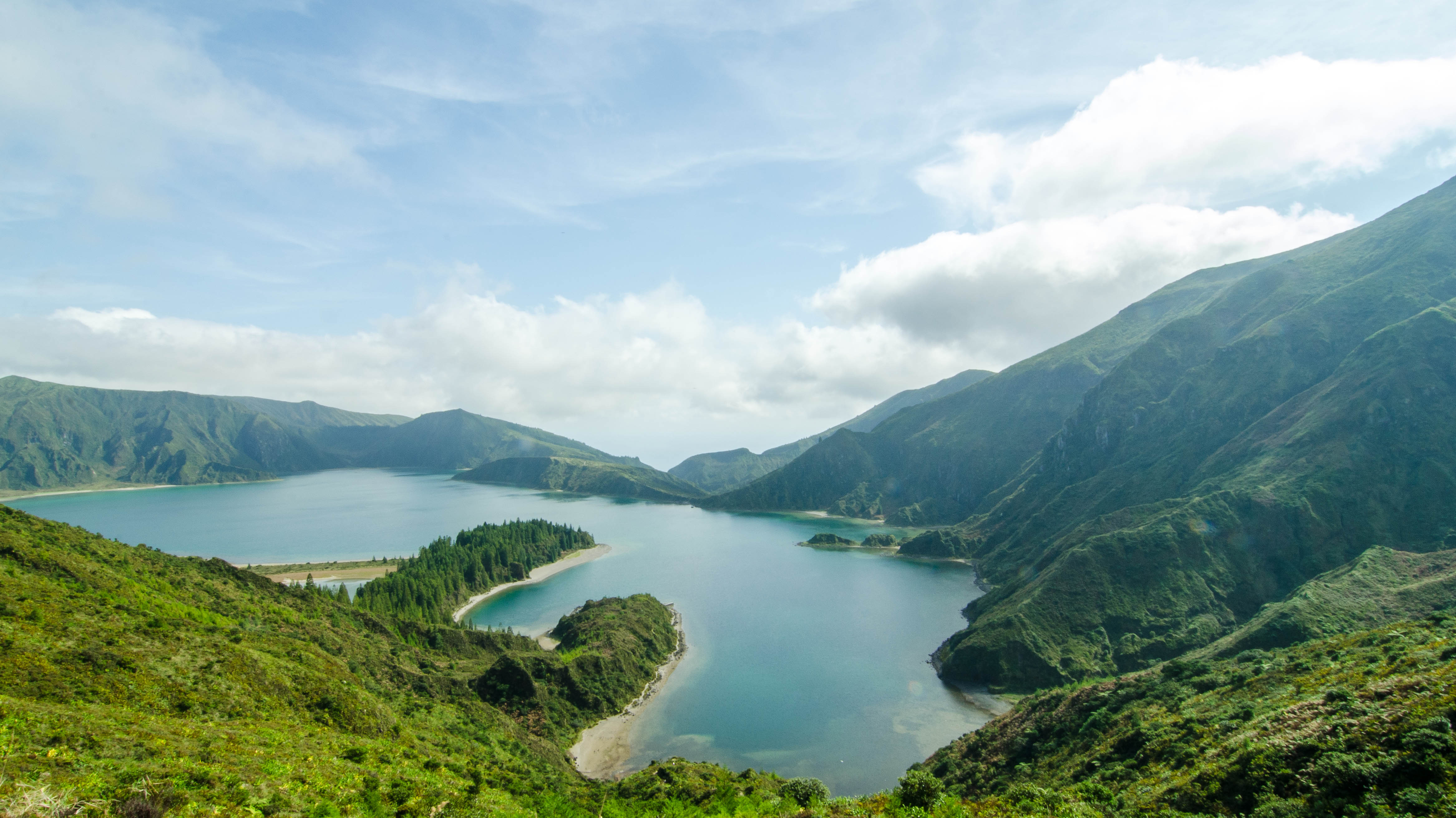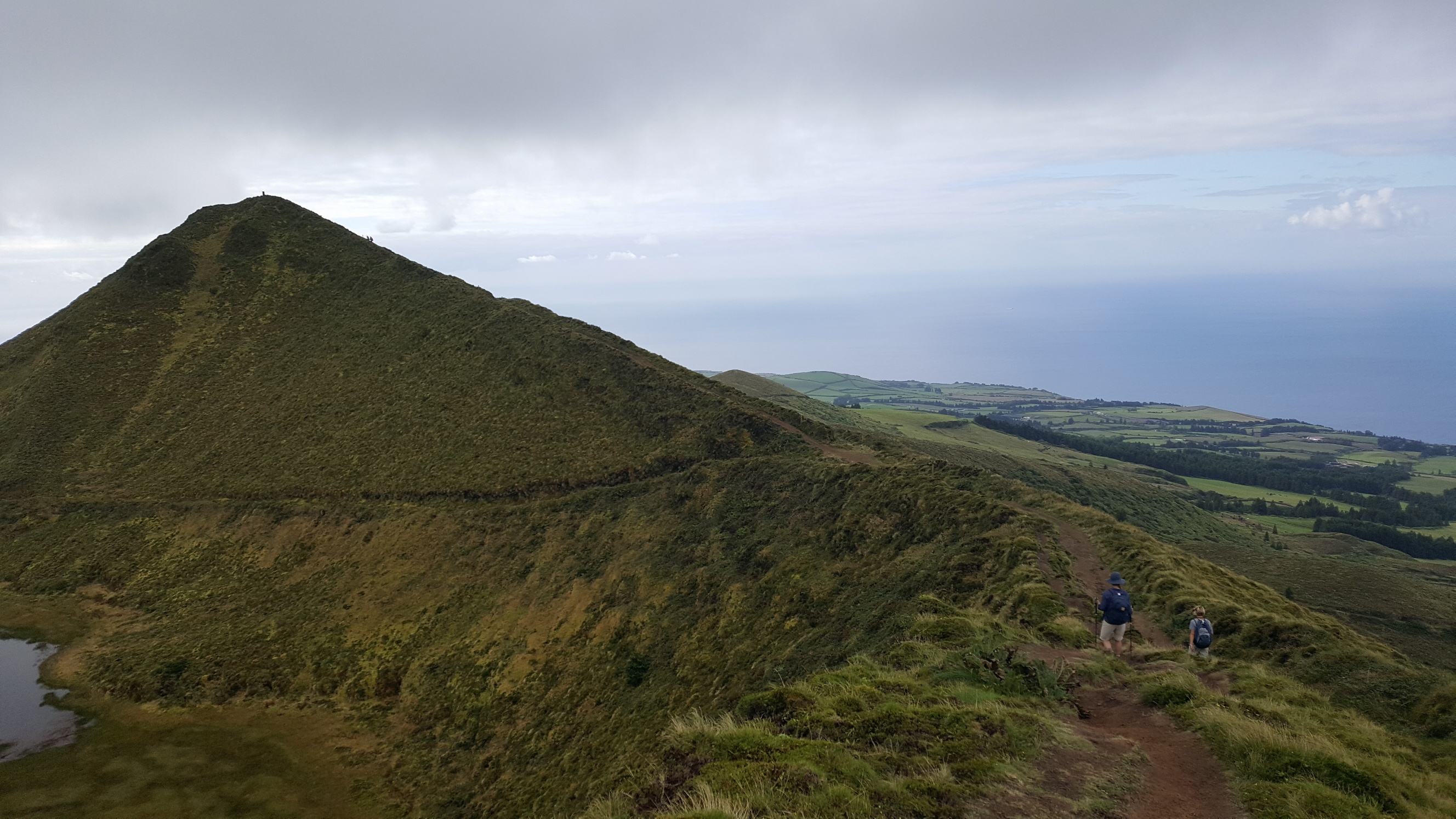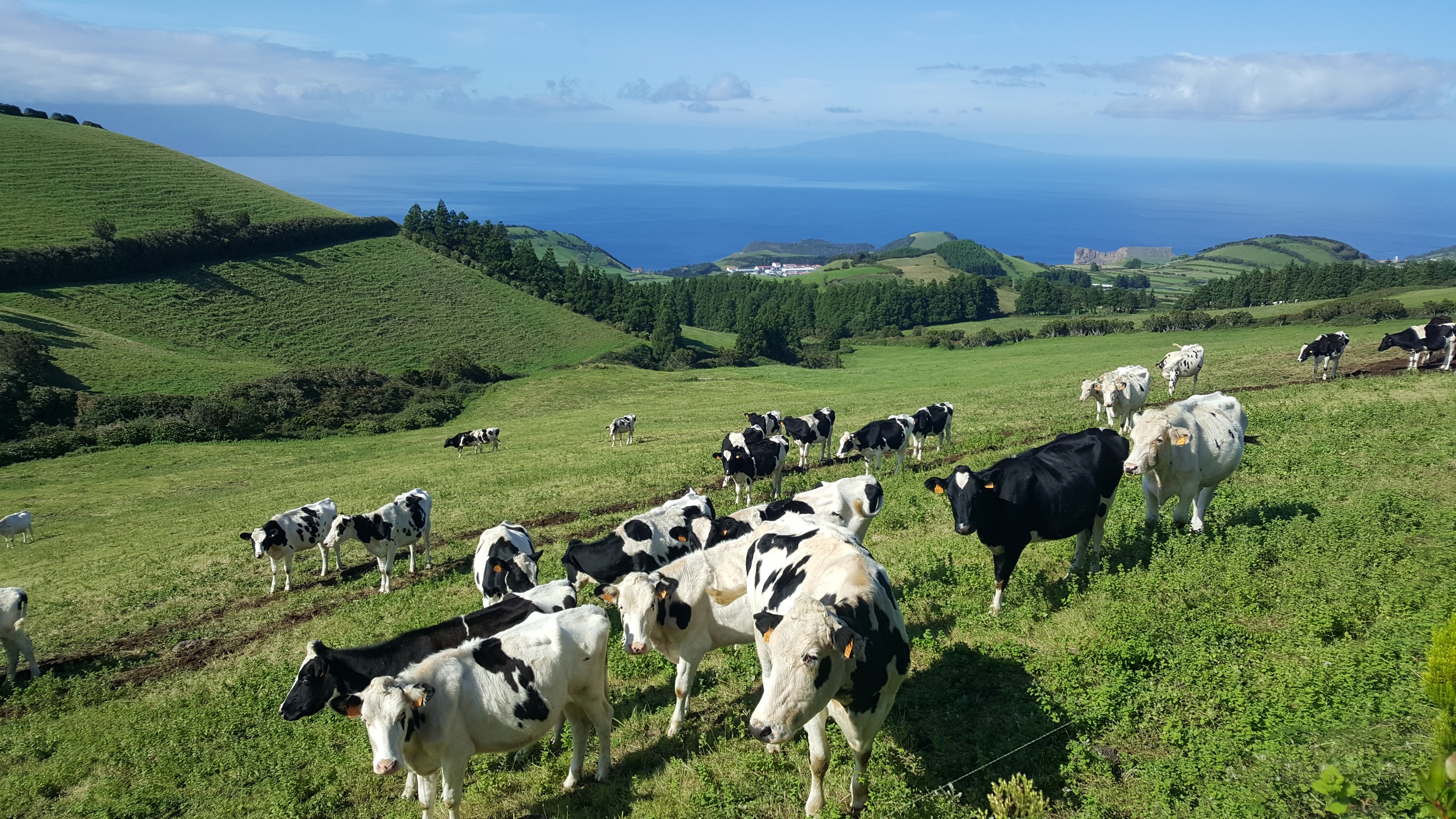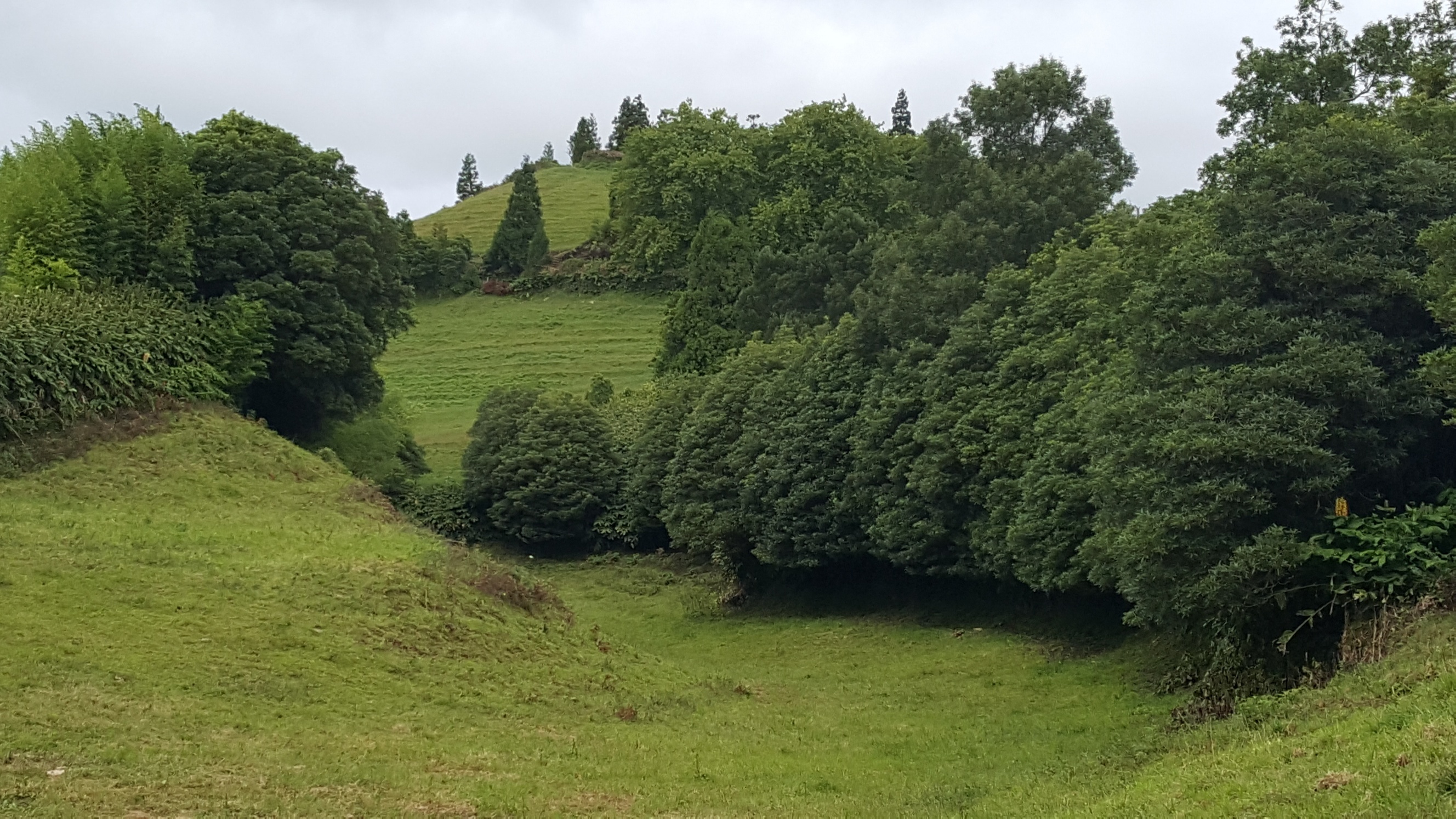The Azores
Key information: The Azores 
- The amazing Azores are awash with grassy volcanoes, with giant heather, blue hydrangeas and vivid pastures below, the sea an ever-joyous backdrop.
- Truly some of the world’s best walking, from a towering volcano to high ridges to a host of calderas to fields, gorges and clifftops.
Walkopedia rating
- Walkopedia rating97
- Beauty35
- Natural interest16
- Human interest13
- Charisma33
- Negative points0
- Total rating97
Vital Statistics
- Length: Your choice
- Maximum Altitude: 2,350m
- Level of Difficulty: Variable
WALK SUMMARY
The amazing Azores sit on the Central Atlantic Ridge some 3 hours west of Portugal. They are an archipelago of volcanic islands extended across several hundred kilometres of ocean, laid out in sub-groups. They are beautiful vivid green from their oceanic climate, save for the scarrings of more recent eruptions. With their hedges of hydrangea and giant heather and herds of placidly grazing cattle, they often look like Ireland on steroids. Then you find yourself in a rocky historic vineyard or picking your way across a lava flow and know that you are somewhere altogether more exotic.
As the Azores were born of fire at the triple junction of the African, Eurasian, and North American tectonic plates, there are volcanoes and their remains everywhere. This takes the form in some cases of a long, interrupted series of craters now forming the thrilling central ridge of a long and slender island, and in others more a circular island around one grand old caldera, but they all sport endless minor craters, fumeroles and other formations along their flanks, often wonderfully verdant, covered in deep mattresses of grass or vivid scrub. You may find a belt of giant heather below that, and below that fields and elegant Japanese and Azores cedars (the latter actually a type of juniper), with hedges and roadsides awash with blue hydrangeas in summer. The middle hillsides are entrancing, cattle grazing the steep little emerald fields with the sea an ever-joyous backdrop. Much of it is not wild country, but it always is ravishingly pretty.
You don’t really come here for the animal life: there are no indigenous mammals and not that many birds, considering – but the islands are thousands of kilometres from any significant landmass, so what was here before man got here accidentally.
The towns are mainly atmospheric old fishing harbours, good places to linger, and linked by ferries and some flights. There are some lovely places to stay, from historic buildings to comfortable guest houses. The food is generally not as thrilling as you might hope. The seafood and meat can be delicious, but vegetarians will find it disappointing.
There is endless walking on the Azores, from high and challenging to low and easy, but it is always beautiful and interesting, hence the Azores are so high in our Top 100 walks. Given the changeable weather, even ambitious walkers will need to spend some time on the lower routes, but they won’t be disappointed.
Central Group
Sao Jorge: Sao Jorge can only be described as walking magic. This slender island is essentially a long, interrupted series of old volcanoes which now forms the thrilling central ridge, with endless minor craters and other formations along their flanks. Its high hilltops command thrilling views across to Pico and on into Atlantic infinity. Sao Jorge is called the walkers’ island and you can see why: there is a mass of beauty and interest to be enjoyed in this smallish package. See the full selection here: the finest are probably:
Central Ridge: finest walks in the Azores and a high Top 100 walk. Walkopedia fizzes with excitement just thinking of it. A series of volcanic cones, craters and other formations, some nestling little tarns to their heart, lines the long central ridge, with endless views to the other Islands which decorate the infinitely receding Atlantic. They are covered in vivid grassy vegetation, with dark giant heather and woodlands along the mid slopes and a patchwork of little fields below that.
Piquihino da Urze to Faja de Cubres: This fine and very varied walk explores remote valley and coast and a traditional fishing village.
See more on Sao Jorge and its walks here
Pico: dominated by its huge eponymous volcano, the highest mountain in Portugal, Pico is host to several outstanding walks and worth several days' attention. Star turns include:
Pico volcano: this extraordinary stand-alone 2,350m volcano soars above the western end of Pico island, an almost-perfect cone on which balances a steep and slightly sinister mini-cone. It is a fascinating place, awash with the weird remains of lava flows and peppered with vents and is clothed in vivid heather and other sparkling shrubs, so is a delightful place to walk – but is a long and arduous slog. Wonderful views.
Historic Vineyards: the fascinating world heritage listed vineyards are well worth exploring.
Descent of the old track from Pico to Madelena: from a fascinating short lava tunnel high above Madalena, descend steadily across fields then on an old track, through beautiful rocky fieldsthen woodland and agricultural plots, directly towards Madelena and Faial across the water.
Caminho das Lagoas: a long walk along the eastern spine of the island between cones and craters and past numerous lovely lakes, all the time in high pasture and some shrublands and with huge vistas opening and closing.
See more on Pico and its walks here
Faial: Faial is a bit different from its neighbouring islands Pico and Sao Jorge. Rather than being long and thin, it is roughly circular, with a western tail. It is centred on the magnificent caldera at its heart. But its vegetation and atmosphere are similar, especially to Pico. Faial is not as rich in walks as its neighbours.
The great walk here is the long Ten Volcanoes route, a series of fascinating and beautiful tableaux, from the high caldera rim to a levada in cedar forest, to cones and giant heather bushland to the eruption badlands at the island’s tip.
Walkopedia based itself in the lovely and historic port of Horta, resupply stop on the Atlantic crossing and destination of ocean yacties, for a few days while we explored Faial and Pico, which is a 30 minute ferry ride away. Better food and a stunning hotel in the old fort.]
See more on Faial and its walks.
Eastern Group
Sao Miguel: the largest of the Azores islands, essentially a long series of eroded volcanoes, most of them long extinct but some showing signs of life. There is a series of fabulous calderas where they have collapsed, including famous Sete Cidades, Fogo and Furnas. Sao Miguel is more developed that the other islands, with more good hotels and more consistent food – but sprawling coastal towns and more tourists at the top sites. Approximately west to east, great walks include:
Sete Cidades: this wonderful huge caldera is the Azores’ most famous walk. We can’t overstate its beauty and interest, and it is one of the handful of walks that propels the Azores so high up our Top 100 list. Lots of varied walking opportunities, but time wandering along the rim is a must. See more here
Smaller lakes: a contorted area sprinkled with tarns and small lakes. Time well spent.
Rota da Agua and Janela do Inferno: follow old tracks used for water transport, encountering old bridges, aqueducts, levadas (watercourses) and tunnels. Often fascinating and often beautiful. The high point is the Janela do Inferno.
Lake Fogo: the walk in to beautiful Lake Fogo in its deep crater is wonderfully varied and interesting. This is a place to loiter and take in the atmosphere.
Pico da Barrosa Ridge: a short walk gets you to this 947m summit, which has huge views over the surrounding area, from lake to you sea. A steady ridge leads south from here, which makes for easy but inspiring walking.
Cha Gorreana tea plantation: if you haven’t walked in tea plantations, do explore these.
Furnas Lake: this is easy and rather suburban walking around the crater lake of the Sao Miguel’s active volcano, yet with lots of interest (take a bow super-heated mud pools and the sheer, complex cliffs of the huge caldera) and charm.
Eastern High Ridge and Pico da Vara: this long high ridge takes in several summits including the highest point on the island and commands regular knock-out views.
Wonderful.
Sanguinho Valley: this thickly wooded valley takes you to a beautiful waterfall, returning via the characterful old village of Sanguinho.
See more on Sao Miguel and its walks. {link]
Santa Maria, south of Sao Miguel, is a quiet and gentler place with unique white sand beaches. It is home to several good walks.
Cross the island between its two white sand beaches, from Praia Formosa (south coast) to Sao Lourenco Bay (northeast coast), talking in the highlands and a diversion to Pico Alto, the highest peak on Santa Maria (circa a lordly 587 metres), with huge views including Sao Miguel on a clear day. 11.5 km, 4.5hrs+, moderate to strenuous. See more at https://trails.visitazores.com/en/trails-azores/santa-maria/areia-branca
Pico Alto to Anjos. For a different way of enjoying the high ground, start from the forest road to the peak area, take in Pico Alto, and make the long, undulating descent to Anjos on the north-west coast, through attractive farmland. 12 km. Moderate to strenuous. (You can start at Banaeiros if you want something shorter).
A good-looking circuit of the high ground from Pico Alto, including grand views and a caldera overlook. More at: https://trails.visitazores.com/en/trails-azores/santa-maria/pico-alto
Santo Espirito to Maia via Ribeira de Aveiro waterfall. An interesting and lovely, varied walk which takes in traditional vineyards and the stunning knife-edge ridge leading out to the Goncalo Velho Lighthouse. More at: https://trails.visitazores.com/en/trails-azores/santa-maria/santo-espirito-maia
Western Group
Flores in the far west (Europe’s most westerly point) has huge sea-cliffs down which spectacular waterfalls plunge. https://trails.visitazores.com/en/trails-azores/flores has some excellent-looking walks if you get this far.
Corvo: the Azores’ smallest island has a huge, green, lake-decorated, amazing caldera which Walkopedia would LOVE to walk round. https://trails.visitazores.com/en/trails-azores/corvo/caldeirao
____________________________________________________________
Walkopedia met many of the above walks through recommendations from the excellent Inntravel, who organised our expedition. See also the excellent https://trails.visitazores.com/en/trails-Azores for lots of walking ideas, if you want more detail (and maps!) or further options.
This can be demanding walking in high mountains with uncertain weather. Come prepared.
Your thoughts are welcome! Please help us by making suggestions and sending photos! Thank you!
Other accounts: share your experiences
Your comments on this walk, your experiences and suggestions, and your photos are very welcome. Where appropriate, you will be credited for your contribution.
We have a lot of helpful practical information and tips about this walk, covering everything from the best books and maps, to timing and weather, geting there, possible problems, whether you need a guide and where to find them, and useful websites. This section is only open to members.
Membership is FREE AND JOINING TAKES 30 SECONDS. To login or sign up click here
Safety and problems: All walks have inherent risks and potential problems, and many of the walks featured on this website involve significant risks, dangers and problems. Problems of any sort can arise on any walk. This website does not purport to identify any (or all) actual or potential risks, dangers and problems that may relate to any particular walk.
Any person who is considering undertaking this walk should do careful research and make their own assessment of the risks, dangers and possible problems involved. They should also go to “Important information” for further important information.
Anyone planning an expedition to this place should see further important information about this walk.
Safety and problems: All walks have inherent risks and potential problems, and many of the walks featured on this website involve significant risks, dangers and problems. Problems of any sort can arise on any walk. This website does not purport to identify any (or all) actual or potential risks, dangers and problems that may relate to any particular walk.
Any person who is considering undertaking this walk should do careful research and make their own assessment of the risks, dangers and possible problems involved. They should also go to “Important information” for further important information.
OTHER ACCOUNTS
share your experiences
Add your experiences, suggestions and photos. We would be delighted to receive your writing and ideas (which will be attributed appropriately where published).
Anyone planning an expedition to this place should see further important information about this walk.
Responsible travel matters, a lot. How you travel will make a real difference - for better or worse. PLEASE consider this when making plans. Read more



